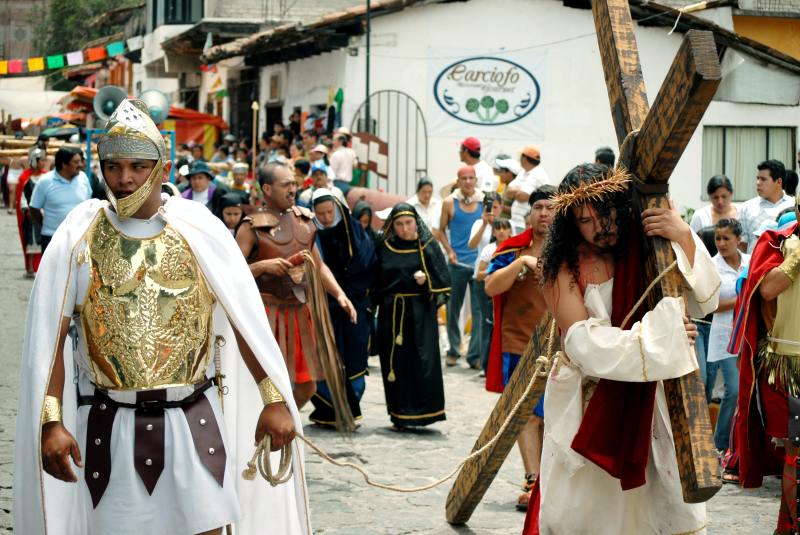
Holy Week is a particular time for solemnity. It is celebrated worldwide with different traditions and practices, such as "la quema de Judas" in Mexico and "Visita Iglesia" in the Philippines. It begins on the Sunday of Palms and lasts until Easter Sunday.
According to the Archdiocese of Saint Paul and Minneapolis Catholic Center, Holy Week is the most important period in the entire liturgical year, standing at our calendar's head. It is a celebration of the Paschal Mystery, which commemorates the suffering and death of our Lord, Jesus Christ, as well as his resurrection from the dead as a conqueror, his victory over death and wickedness, and his exaltation by his Father.
Traditions and Practices on Holy Week
As per Cultural Awareness International, Palm Sunday is commonly celebrated with a parade and procession of palm fronds meant to represent those laid at Jesus' feet. On Maundy Thursday, Christians mark the Last Supper that took place the night before Jesus was crucified. Good Friday is the day of the year when most Christians remember and reflect upon Jesus's crucifixion and death. Moreover, Holy Saturday is the final day of Holy Week and marks the culmination of the spiritual and physical preparations for the resurrection of Jesus. In countries such as Mexico, Poland, and the Philippines, it is celebrated annually with different traditions and practices.
1. Mexico
One of the holidays that receives the most significant amount of attention from the general public in Mexico is Holy Week, also known as Semana Santa. Because of this, many schools and businesses close their doors during Holy Week and the following week to commemorate the holiday with time-honored customs such as processions, reenactments of the Passion, and native rituals. On Holy Saturday, one such practice is "la quema de Judas," which translates to "the Burning of Judas." Burning or setting effigies made of hay, wood, or paper maché on fire with fireworks is common during funerals. Many believe the flames are cleansing, ridding the spectators' souls of anything evil or corrupt. La quema de Judas has been attended by people from all over Mexico and other countries in Latin America ever since the time of the conquistadors. It used to be a religious practice, but it has become more secular over the years. This tradition, which continues to this day, honors the rich history of Mexico.
2. Poland
Easter is celebrated in Poland, a country whose population is predominantly Catholic, with a mix of Christian and pagan customs. On Palm Sunday, Poles decorate their homes with palm fronds handcrafted from various branches, flowers, and ribbons. On the Friday before Easter, many people pay a visit to a grave that has been decorated with flowers and candles. Families will celebrate Easter by decorating baskets and stuffing them with traditional foods such as bread, sausage, hard-boiled eggs, and a miniature lamb made from sugar, butter, or plastic on Holy Saturday. After that, they take the baskets with them to mass, where a priest will bless them, and then they are set aside to remain untouched until the following Sunday morning.
3. Philippines
Holy Week celebrations in the Philippines are influenced by Spanish Catholicism and the indigenous practices before Spanish colonization. The moriones festival, in which Roman soldiers reenact Jesus' walk to Calvary, features a statue of Santo Entierro (holy internment) on a flower-covered Calandra. On Good Friday, many people try to keep as much noise as possible to a minimum by turning off their radios and televisions to concentrate more fully on the day's significance.
Based on an article from the Guide to the Philippines, the Roman Catholic practice of visiting and praying in at least seven churches daily is known as the Visita Iglesia and most commonly takes place on Maundy Thursday. When they observe Visita Iglesia, most Filipinos pray the 14 Stations of the Cross, typically at two stations at each church. Additionally, during the Spanish colonial era, Augustinian missionaries introduced this tradition to the country in the 1560s.
Also Read: Good Friday 2023: Understanding, Looking Back at the Rich History of Holy Week
Importance of Holy Week for Christians
According to Helpline PH, Christians are encouraged to pray, meditate, and refresh their faith during the Holy week. It brings to mind the suffering, death, and subsequent resurrection of Jesus Christ, the central tenets of the Christian faith. This week brings us closer to God and helps us get ready for the celebration of Easter, which is full of joy.
However, as believers attempt to balance the demands of their jobs, families, and faith, Holy Week can be difficult for them. Likewise, one may experience intense feelings throughout Holy Week, which can be motivating and challenging at various points. Yet, we can better comprehend our beliefs by participating in various time-honored events and observing time-honored traditions.
Holy Week is an exceptional time for spiritual development because it enables us to strengthen our faith and brings us into closer proximity to the divine presence of God. It allows us to delve deeper into the central aspects of Jesus' life, such as His excruciating death and miraculous resurrection, which are essential to our religious beliefs.
This powerful journey, which is deeply embedded in significant learnings, opens the door for transformative experiences and encourages us to embody love, compassion, and humility with greater intensity while going about our daily activities.
Related Article:Exploring the Spiritual Significance of Fasting During Ramadan, Lent, and Other Holy Days

















